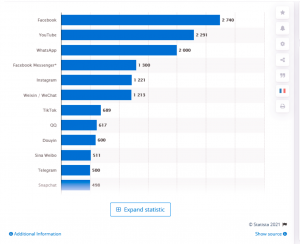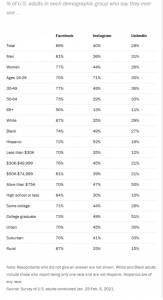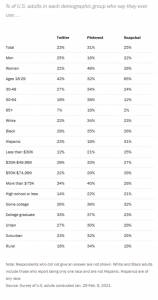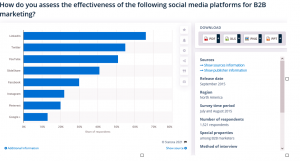7 Social Media Marketing Mistakes You’re Making
7 Social Media Marketing Mistakes You’re Making

There are billions of active social media users worldwide, and the number continues to grow by the day. A growth that has led to social media platforms becoming one of the most influential virtual spaces.
Traditional methods of marketing like TV commercials tend to be a one-way communication—brand to the customer. But social media marketing encourages engagement. It creates multi-way communication in that:
- Businesses can communicate with customers
- Customers can engage with the brand by offering feedback.
- Customers can communicate with other customers by sharing posts.
As a brand owner or marketer, you get to reach a multitude of potential buyers in seconds, especially when using paid social media.
There is plenty you can gain from social media marketing. But if your efforts are not bearing any fruits, you could be guilty of some common errors most people make. Being aware of these social media marketing mistakes can help you correct and avoid them.
1. You Are Working Blindly
One of the biggest mistakes you could make in your social media marketing is shooting in the dark and expecting results. Instead, you need to take it with the seriousness you would take any other marketing campaign.
Create a plan—a clear social media marketing strategy. It’s the first ingredient of a successful social media account.
A social media marketing strategy will ensure that:
- You are posting content that is relevant to your goals. It will prevent you from wasting your efforts and resources on a social media campaign that’s sure to fall flat.
- You are scheduling and arranging posts early enough. Posting consistently helps you grow and maintain a strong organic online presence.
So, how do you create an effective strategy?
A simple guide is not going to cut it. You need a master plan that addresses:
- What you want to gain from social media. A new source of leads? Brand awareness? If you don’t know what you want, you can’t get it.
- Who you are targeting.
- Your plan of action. What kind of posts will you make? How will you market the posts to reach your intended audience? Do you need to add more video content?
- The team that will be responsible for maintaining your accounts.
- The time and funds you will allocate to social media marketing.
- Your key performance indicators.
Know what you want from social media and how you will get it. And you will be on the path to achieving your full social media potential.
2. You Are Targeting the Wrong People
You could have a super-plan in place. But if you are targeting the wrong audience, then again, you will have a case of wasted efforts and resources. You’ll end up with tons of followers who have little to contribute to your goals?—an audience that doesn’t represent your ideal customers.
Overall, Facebook is the most used social network worldwide.

However, this does not mean you should focus your marketing efforts on Facebook.
First, define your target audience. This is the market segment that is most likely to have an interest in your product or service. You can base it on age, income level, education, location, or behavior.
If you are active on multiple social media channels, pay special attention to the platform popular among your target audience.
For instance, data shows that Instagram is most popular among 18 to 29-year-olds.

Pinterest is most popular among women, while Snapchat and Twitter are most popular among 18 to 29-year-olds.

And if you are in the B2B space, LinkedIn might work better for you.

People are quick to ignore irrelevant content. For this reason, try not to make assumptions about your target audience.
Study them, then customize your content to fit their needs and expectations. Your content should bring value to your audience and give them a reason to engage with it.
Your tone should also fit the social media platform you are using. The kind of content your target audience expects differs among platforms.
Facebook users, for instance, expect an informal, playful, and engaging tone. On the other hand, LinkedIn works best with a reasonably formal tone, and Instagram is mostly about aesthetics.
Maximize your reach of the target audience by using features like subtitles and captions. They make it easier for your audience to:
- Watch your videos in sound-sensitive environments, such as offices or noisy places.
- Comprehend dialogue where the participants are speaking fast.
- Stay attentive, helping you pass your message across.
- Access your content despite having hearing problems.
3. SEO Best Practices Are Not Part of Your Social Media Marketing
A mistake most brands make is ignoring the power of SEO in making their social media campaigns successful.
Just like you’re keen on SEO when creating blog posts, landing pages, and other content for your website, you should do the same with social media.
Practicing SEO can help your profile rank higher in search results. This drives organic traffic to your profile and grows your followers.
The amount of likes, shares, and comments your posts receive affects your social media ranking and reach. So, to start with, you need to post frequently and post high-quality and engaging content. Then make it easy for your followers to share your posts by including compelling CTAs.
Make use of keywords. Find the best performing phrases and words once you do your keyword research for your articles and blog posts. Then, use them in your social media posts.
Visual content is one of the strongest SEO techniques you can use. Use relevant and quality images, videos, and GIFs that load fast.
Taking the step to add subtitles to video and captions to images and GIFs also works in your favor. Google and other search engines cannot watch a video. But the search bots can crawl the text on it and index the video, making your posts more discoverable.
Put SEO tactics into practice, and you’re sure to experience an increase in your reach.
4. Excessive Brand Promotions With No Real Content
For most people, social media is a place to network and communicate, share opinions, get updated about current events, and get inspired.
So if you are using it only to promote your brand and post automatic backlinks to your website, you’re getting it wrong.
You want to create content that arouses the audience’s interest and triggers conversations.
Join conversations on hot topics, but steer away from anything divisive, such as politics. Instead, observe what is happening in your niche and what your audience is already discussing. Then create content that responds to these issues.
Aim at making most of your content valuable and interesting to your audience. And the rest can involve promoting your products or services, but with a lot of engagement and social interaction.
As you post non-promotional content, ensure that the quality is consistent. Unfortunately, most brands make the mistake of assuming any post is better than no post at all. But unlike a personal social media account, a brand’s account is subject to ruthless scrutiny.
One offensive post could make your consumers and potential leads unfollow you. Or, if you are too official, they could see you as boring and begin ignoring your posts.
Stick to posts that reflect your brand and connect with your target audience. Be sociable. And when you do promote your brand, do it subtly.
5. You Are Not Using Hashtags
The famous #hashtag. Almost everyone knows what it is. But few know how to use it properly, when, or even why.
A hashtag begins with the “#” symbol followed by a keyword, with no spaces or punctuations. They provide a way to label your content and associate a post with a particular topic.
Every time a user wants to filter relevant conversations on a particular topic or carry out a hashtag search, they can find your content on the topic. Thus, it helps your target audience find you.
Here are a few pointers for using hashtags:
- Get specific with your hashtags. Generic hashtags like #sports will not get you the increased impressions or reach you seek. But #sportsshoes is a better choice.
- Use hashtags to talk about trending topics and get your brand in front of thousands of people.
- Be careful what you hashtag. So naturally, you want to stay away from sensitive topics that could make people question your brand’s values.
- Keep your hashtags short and easy to remember.
- Don’t overuse hashtags.
- If you plan on starting a new hashtag, ensure that it’s unique and catchy. Something that people will remember when referencing your brand.
Hashtags are a powerful method to gain exposure on social media. They can strengthen your social media presence and help you market your brand more effectively.
6. Your Profile Is Faceless With No Human Interaction
Social media is all about connecting with other people. But a mistake most brands make is relying too much on automation.
Excessive automation could make you lose your human touch.
It’s essential to be present. Participate in the conversation in the comment section. It will improve the value of your social presence and help you build valuable relationships with your audience.
The kind of responses you make also matter. A brand account that is too corporate has no place on social media. When you use stock responses, your audience will know. And they will stop engaging with your posts.
Add a human touch to every post and comment you respond to. For example, when responding to a question from your audience, personally address the individual instead of using pre-crafted marketing and corporate messages. Be authentic, delightful, and inspiring.
You’re going to face some negative responses, that’s for sure, but you need to maintain your cool. Respond to any concerns the person in question may have in a friendly and polite way. This will prevent the conversation from turning negative, which can be damaging to your reputation.
Take every positive and negative comment as a chance to talk directly with a potential customer.
Avoid limiting your social interactions to the marketing department. Instead, involve other departments, such as billing and production. This will ensure prompt and comprehensive responses to your followers’ questions.
When you take the time to respond to comments, and not in a robotic way, it establishes strong connections with your followers, and they’ll like you more.
It’s also best to make personalized and meaningful interactions with the content of other people. This can range from influential professionals in your niche to experts who share the same views as your brand. It will increase the exposure of your content and give you wider access to your target audience.
7. You Neither Track Performance nor Have a Clear Call to Action
You can have entertaining, meaningful, and SEO-friendly content. But if you are not going to tell your audience what to do next, your efforts are going to waste.
Your audience needs the motivation to take the next step to become a customer.
Include a call to action in your posts. It could be an invitation to:
- Visit your website.
- Like, share, or comment on the post with their thoughts.
- Sign up.
- Shoot you an email.
Once you have CTAs in place, measure the success of your marketing efforts using social media analytics. You can use the metrics provided by the social media platform or use analytics software.
Tracking analytics can give you an extensive view of your social media performance. In addition, they provide actionable insights that you can use to improve your social media marketing tactics and woo the right customers.
Here are some essential analytics to track:
| Analytics | What it entails |
| Awareness | How big are your current and potential audience?
What are the demographics? |
| Engagement | How does your audience react to your posts?
Is there any fluctuation in engagement, and what kind of posts cause the fluctuations? |
| Conversion | How many of your followers heed your call to action.
Is the traffic that comes from social media to your website likely or not to convert? |
| Consumer | How does your audience feel about your brand? |
| Influence | Who is driving conversations about your brand?
Do they get others to participate in these specific conversations? |
| Share of voice | What’s the volume of the conversation about your brand, and how does it compare to competitors? |
Tracking analytics shows you the impact of your past actions. And you can use these insights to improve your social media marketing strategy continually.
Ready to Step up Your Social Media Marketing?
Have you been making any or all these social media marketing mistakes? Then, it’s time to remedy the situation.
- Start by writing down your social media marketing strategy and target audience.
- Next, create a social media calendar. Make a plan on how you will create meaningful, SEO-friendly, and share-worthy content that utilizes hashtags and CTAs. You don’t have to worry about your visuals. Instead, use Keevi, a powerful online content editor. Keevi will make your images, videos, and GIFs SEO-friendly, accessible, and high-quality.
- Finally, measure the results of your social media marketing efforts, and make improvements where needed.
Take these steps, and you are sure to have your brand presence felt on social networks.
Imagee Credit: Olenka Serfienko; Pexels; Thank you!
The post 7 Social Media Marketing Mistakes You’re Making appeared first on ReadWrite.
(24)


